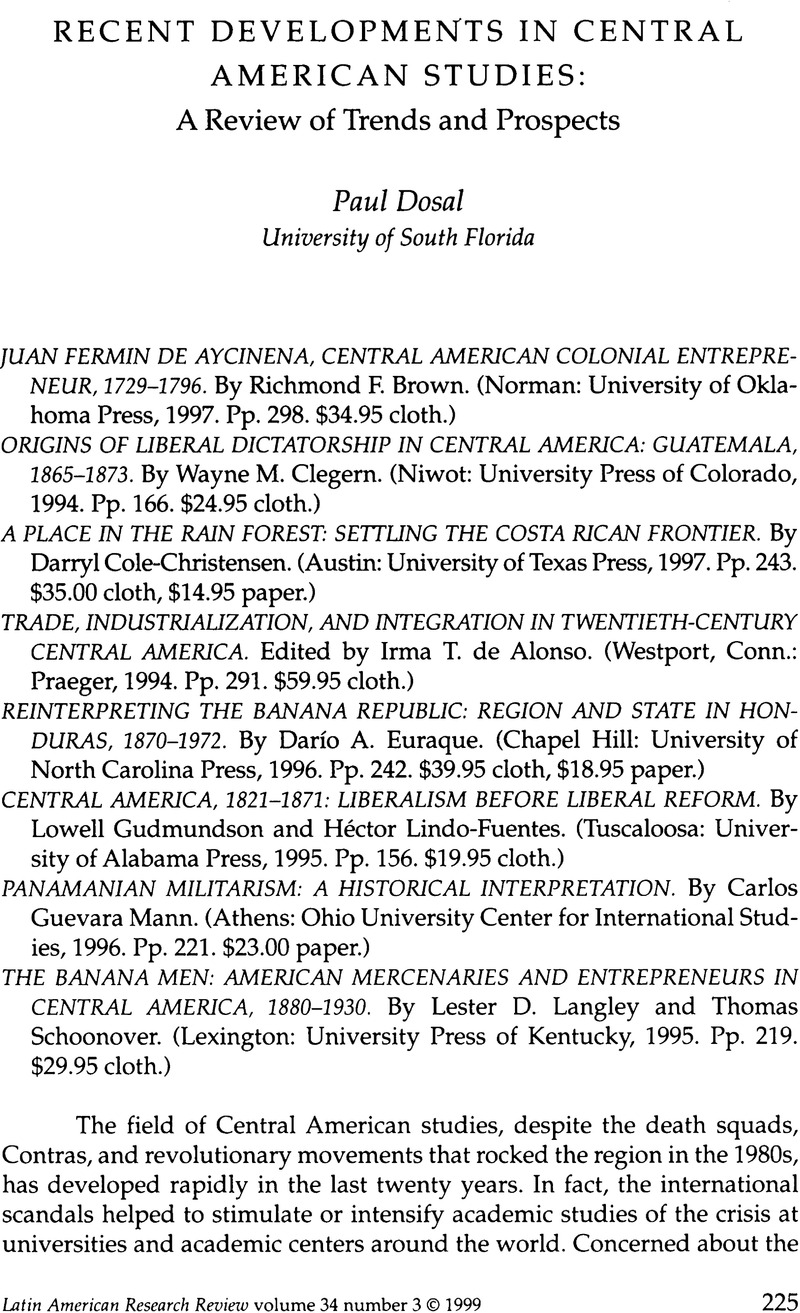No CrossRef data available.
Article contents
Recent Developments in Central American Studies: A Review of Trends and Prospects
Review products
Published online by Cambridge University Press: 05 October 2022
Abstract

- Type
- Review Essays
- Information
- Copyright
- Copyright © 1999 by the University of Texas Press
References
Notes
1. Richard Immerman, The CIA in Guatemala: The Foreign Policy of Intervention (Austin: University of Texas Press, 1982); Jim Handy, Revolution in the Countryside: Rural Conflict and Agrarian Reform in Guatemala, 1944-1954 (Chapel Hill: University of North Carolina Press, 1994); Piero Gleijeses, Shattered Hope: The Guatemalan Revolution and the United States, 1944-1954 (Princeton, N.J.: Princeton University Press, 1991); Paul Dosal, Doing Business with the Dictators: A Political History of United Fruit in Guatemala, 1899-1944 (Wilmington, Del.: Scholarly Resources, 1993); and Dosal, Power in Transition: The Rise of Guatemala's Industrial Oligarchy, 1871-1994 (Westport, Conn.: Praeger, 1995).
2. David McCreery, Rural Guatemala, 1760-1940 (Stanford, Calif.: Stanford University Press, 1994); and Robert Trudeau, Guatemalan Politics: The Popular Struggle for Democracy (Boulder, Colo.: Lynne Rienner, 1993).
3. Mario Samper Kutschbach, Generations of Settlers: Rural Households and Markets on the Costa Rican Frontier, 1850-1935 (Boulder, Colo.: Westview, 1990); Lowell Gudmundson, Costa Rica before Coffee: Society and Economy on the Eve of the Export Boom (Baton Rouge: Louisiana State University Press, 1986); and Aviva Chomsky, West Indian Workers and the United Fruit Company in Costa Rica, 1870-1910 (Baton Rouge: Louisiana State University Press, 1996).
4. Jeffrey L. Gould, To Lead as Equals: Rural Protest and Political Consciousness in Chinandega, Nicaragua, 1912-1979 (Chapel Hill: University of North Carolina Press, 1990); and Héctor Lindo-Fuentes, Weak Foundations: The Economy of El Salvador in the Nineteenth Century, 1821-1898 (Berkeley and Los Angeles: University of California Press, 1990).
5. Among the recent works on women in modern Central America, see Margaret Randall, Sandino's Daughters Revisited: Feminism in Nicaragua (New Brunswick, N.J.: Rutgers University Press, 1994); and A Dream Compels Us: Voices of Salvadoran Women, edited by New Americas Press (Boston, Mass.: South End, 1989). On the ethnic dimension, see as examples Philippe Bourgois, Ethnicity at Work: Divided Labor on a Central American Banana Plantation (Baltimore, Md.: Johns Hopkins University Press, 1989); and Nancy L. González, Sojourners of the Caribbean: Ethnogenesis and Ethnohistory of the Garifuna (Urbana: University of Illinois Press, 1988).
6. John E. Kelly, Pedro de Alvarado, Conquistador (Princeton, N.J.: Princeton University Press, 1932); Robert S. Chamberlain, Francisco Morazán, Champion of Central American Federation (Coral Gables, Fla.: University of Miami, 1950); Paul Burgess, Justo Rufino Barrios: A Biography (Philadelphia, Pa.: Dorrance, 1926); Charles Ameringer, Don Pepe: A Political Biography of José Figueres of Costa Rica (Albuquerque: University of New Mexico, 1978); Kenneth Grieb, Guatemalan Caudillo: The Regime of Jorge Ubico, 1931-1944 (Athens: Ohio University Press, 1979); Stephen Webre, José Napoleón Duarte and the Christian Democratic Party in Salvadoran Politics, 1960-1972 (Baton Rouge: Louisiana State University Press, 1979); and Ralph Lee Woodward Jr., Rafael Carrera and the Emergence of the Republic of Guatemala, 1821-1871 (Athens: University of Georgia Press, 1993).
7. Knut Walter, The Regime of Anastasio Somoza, Ί936-1956 (Chapel Hill: University of North Carolina, 1993).
8. Julio Castellano Cambranes, Coffee and Peasants: The Origins of the Modem Plantation Economy in Guatemala, 1853-1897 (Stockholm: Institute of Latin American Studies, 1985).
9. Gudmundson, Costa Rica before Coffee; and Lindo-Fuentes, Weak Foundations.
10. E. Bradford Burns, Patriarch and Folk: The Emergence of Nicaragua, 1798-1858 (Cambridge, Mass.: Harvard University Press, 1991).
11. Frederick Upham Adams, Conquest of the Tropics: The Story of the Creative Enterprises Conducted by the United Fruit Company (Garden City, N.Y.: Doubleday, Page, 1914); and Charles Morrow Wilson, Empire in Green and Gold: The Story of the American Banana Trade (1947; reprint, New York: Greenwood, 1968).
12. Thomas Schoonover, The United States in Central America, 1860-1911: Episodes of Social Imperialism and Imperial Rivalry in the World-System (Durham, N.C.: Duke University Press, 1991).
13. Gleijeses, Shattered Hope; and Gould, To Lead as Equals.
14. Among the many valuable regional histories are John D. Wirth, Minas Gerais in the Brazilian Federation, 1889-1937 (Stanford, Calif.: Stanford University Press, 1977); Robert M. Levine, Pernambuco in the Brazilian Federation, 1889-1937 (Stanford, Calif.: Stanford University Press, 1978); Joseph L. Love, São Paulo in the Brazilian Federation, 1889-1937 (Stanford, Calif.: Stanford University Press, 1980); and Mark Wasserman, Capitalists, Caciques, and Revolution: Elite and Foreign Enterprise in Chihuahua, 1854-1911 (Chapel Hill: University of North Carolina Press, 1984).
15. Enrique Baloyra, El Salvador in Transition (Chapel Hill: University of North Carolina Press, 1982); and Marta Casaus Arzoe, Guatemala: Linaje y racismo (San José, C.R.: Facultad Latinoamericana de Ciencias Sociales, 1992).
16. Several previous studies have been made of the Central American Common Market, including Economic Integration in Central America, edited by William R. Cline and Enrique Delgado (Washington, D.C.: Brookings Institution, 1978); and George Irvin and Stuart Holland, Central America: The Future of Economic Integration (Boulder, Colo.: Westview, 1989).
17. Victor Bulmer-Thomas, The Political Economy of Central America since 1920 (Cambridge: Cambridge University Press, 1987).
18. Rigoberta Menchú, I, Rigoberta Menchú, an Indian Woman in Guatemala, edited and translated by Elisabeth Burgos Debray (London: Verso, 1984); Margaret Randall, Sandino's Daughters: Testimonies of Nicaraguan Women in Struggle (Vancouver, B.C.: New Star, 1981); and Elvira Alvarado, Don't Be Afraid, Gringo: A Honduran Woman Speaks from the Heart, The Story of Elvira Alvarado (San Francisco, Calif.: Institute for Food and Development Policy, 1987).
19. Warren Dean, With Broadax and Firebrand: The Destruction of the Brazilian Atlantic Forest (Berkeley and Los Angeles: University of California Press, 1995).




